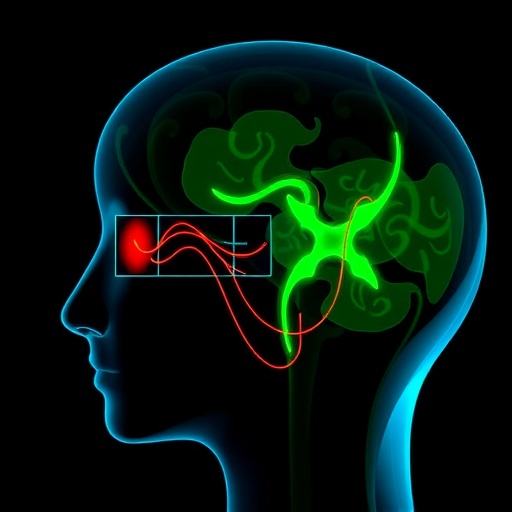In a groundbreaking study published in The Journal of Translational Medicine, researchers have unveiled exciting findings regarding the use of galvanic vestibular stimulation (GVS) as a novel therapeutic approach to aid cognitive recovery in patients suffering from acute unilateral vestibulopathy. This randomized controlled trial conducted by a team led by Oh, SY, and including Nguyen, T.T. and Kang, JJ, marks a significant advancement in our understanding of how targeted neural modulation can facilitate rehabilitation in vestibular disorders.
Vestibular disorders, which affect balance and spatial orientation, can have debilitating effects on patients, often extending beyond physical symptoms to cognitive impairments. Acute unilateral vestibulopathy is characterized by sudden onset vertigo and imbalance, resulting from disruptions in the vestibular system, which is integral to our sense of spatial orientation. The implications of such disruptions can severely impact an individual’s daily life. As such, the pursuit of effective rehabilitation strategies for cognitive recovery in these cases is paramount.
The study set out to investigate the efficacy of GVS, a non-invasive technique that utilizes electrical stimulation to modulate the vestibular system. In the trial, participants with acute unilateral vestibulopathy were divided into two groups: one receiving GVS and the other receiving a placebo. This rigorous methodology ensured that the comparisons drawn from the outcomes were reliable and significantly highlighted the potential of GVS in clinical applications.
Results from the research indicated that those who received GVS exhibited marked improvements in visuospatial cognitive function compared to the placebo group. These findings suggest that GVS may not only mitigate the physical consequences of vestibular dysfunction but could also trigger neuroplastic changes in the brain, promoting cognitive recovery. This dual-action mechanism reveals the potential of GVS as a comprehensive therapeutic approach, addressing both vestibular and cognitive impairments simultaneously.
Further analysis of the trial’s data demonstrated that participants receiving GVS showed enhanced performance in tasks requiring spatial awareness and memory recall. These cognitive assessments were designed to evaluate various dimensions of cognition that are commonly affected in vestibular disorders. The data suggested a dose-response relationship, indicating that increased stimulation corresponded with greater cognitive gains.
It is essential to consider the underlying neural mechanisms driving these improvements. The vestibular system is closely tied to several cortical areas involved in cognitive processing. By stimulating the vestibular pathways, GVS may foster communication between these brain regions, enhancing integrated functions such as spatial navigation and memory encoding. This relationship could have profound implications for developing targeted interventions in neurorehabilitation.
The timing of GVS administration relative to the onset of vestibular symptoms is another critical factor that the researchers explored. Their findings indicate that earlier intervention with GVS leads to improved cognitive outcomes. This highlights the importance of prompt medical attention following vestibular episodes, as early treatment could significantly alter the recovery trajectory for affected individuals.
Moreover, the safety profile observed in the study is reassuring. GVS is a non-invasive technique with minimal side effects reported by participants. This characteristic makes it a patient-friendly option for individuals seeking rehabilitation without the risks associated with pharmacological treatments or more invasive procedures.
The implications of these findings extend beyond immediate clinical applications. Understanding the potential of GVS opens the door to further research into its effects on other populations with cognitive impairments, such as those recovering from stroke or traumatic brain injury. The versatility of GVS as a promising tool in cognitive rehabilitation aligns with broader efforts in the medical community to innovate care strategies for a diverse array of neurological conditions.
While this study is a significant milestone, the authors caution that further research is necessary to solidify GVS as a standard treatment modality. Follow-up studies are needed to explore the long-term effects of GVS on cognitive recovery and to identify optimal stimulation protocols that maximize patient outcomes. Overall, the encouraging results present a compelling case for the adoption of GVS into clinical practice, yet they serve as a call to action for the research community to delve deeper into this promising domain.
In conclusion, the recent randomized controlled trial underscores the vital role of innovative techniques like galvanic vestibular stimulation in addressing both the physical and cognitive ramifications of vestibular disorders. By effectively harnessing the principles of neural modulation, we can potentially transform rehabilitation practices and enhance the quality of life for countless individuals affected by acute unilateral vestibulopathy and similar conditions. As the field continues to advance, the collaboration between neuroscience and clinical practice will be crucial in unlocking new therapeutic horizons for cognitive recovery.
Subject of Research: The use of galvanic vestibular stimulation (GVS) to promote cognitive recovery in acute unilateral vestibulopathy.
Article Title: Galvanic vestibular stimulation promotes visuospatial cognitive recovery in acute unilateral vestibulopathy via targeted neural modulation: a randomized controlled trial.
Article References:
Oh, SY., Nguyen, T.T., Kang, JJ. et al. Galvanic vestibular stimulation promotes visuospatial cognitive recovery in acute unilateral vestibulopathy via targeted neural modulation: a randomized controlled trial.
J Transl Med 23, 991 (2025). https://doi.org/10.1186/s12967-025-07036-7
Image Credits: AI Generated
DOI: https://doi.org/10.1186/s12967-025-07036-7
Keywords: Galvanic vestibular stimulation, cognitive recovery, acute unilateral vestibulopathy, neural modulation, randomized controlled trial.




